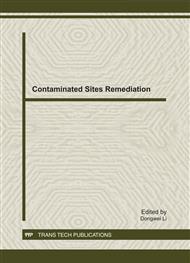[1]
Costagliola P., Benvenuti M., Chiarantini L. et al., Impact of ancient metal smelting on arsenic pollution in the Pecora River Valley, Southern Tuscany, Italy, Applied Geochemistry, 23(5)(2008) 1241.
DOI: 10.1016/j.apgeochem.2008.01.005
Google Scholar
[2]
Manz M. and Castro L. J., The environmental hazard caused by smelter slagss from the Sta. Maria de la Paz mining district in Mexico, Environmental Pollution, 98(1)(1997) 7.
DOI: 10.1016/s0269-7491(97)00107-3
Google Scholar
[3]
BH M. and CS A., Heavy metal contamination of water in coastal and inland areas of Vasai region, India, RESEARCH JOURNAL OF CHEMISTRY AND ENVIRONMENT 12(2) (2008) 30.
Google Scholar
[4]
Malviya R. and Chaudhary R., Factors affecting hazardous waste solidification/stabilization: A review, Journal of Hazardous Materials, 137(1) (2006) 267.
DOI: 10.1016/j.jhazmat.2006.01.065
Google Scholar
[5]
Suzuki I., Microbial leaching of metals from sulfide minerals, Biotechnology Advances, 19(2) (2001) 119.
DOI: 10.1016/s0734-9750(01)00053-2
Google Scholar
[6]
Edwards K. J., Hu B., Hamers R. J. et al., A new look at microbial leaching patterns on sulfide minerals, FEMS Microbiology Ecology, 34(3) (2001) 197.
DOI: 10.1111/j.1574-6941.2001.tb00770.x
Google Scholar
[7]
S I. and G D., Removal of Chromium (III) from Aqueous Solution by Pretreated Microbial Waste Biomass, RESEARCH JOURNAL OF CHEMISTRY AND ENVIRONMENT 13(2) (2009) 29.
Google Scholar
[8]
P S., W C. and C T., Heavy metals removal from contaminated soil by Siam Weed (Chromolaena odorata) and vetiver grass (Vetiveria zizanioides), RESEARCH JOURNAL OF CHEMISTRY AND ENVIRONMENT, 12(3) (2008) 23.
Google Scholar
[9]
Han J. -G., Hong K. -K., Kim Y. -W. et al., Enhanced electrokinetic (E/K) remediation on copper contaminated soil by CFW (carbonized foods waste), Journal of Hazardous Materials, 177 (1-3) (2010) 530.
DOI: 10.1016/j.jhazmat.2009.12.065
Google Scholar
[10]
Park S. -W., Lee J. -Y., Yang J. -S. et al., Electrokinetic remediation of contaminated soil with waste-lubricant oils and zinc, Journal of Hazardous Materials, 169(1-3) (2009) 1168.
DOI: 10.1016/j.jhazmat.2009.04.039
Google Scholar
[11]
Isosaari P., Piskonen R., Ojala P. et al., Integration of electrokinetics and chemical oxidation for the remediation of creosote-contaminated clay, Journal of Hazardous Materials, 144(1-2) (2007) 538.
DOI: 10.1016/j.jhazmat.2006.10.068
Google Scholar
[12]
Traina G., Morselli L. and Adorno G. P., Electrokinetic remediation of bottom ash from municipal solid waste incinerator, Electrochimica Acta, 52(10) (2007) 3380.
DOI: 10.1016/j.electacta.2006.05.067
Google Scholar
[13]
Wang J. -Y., Zhang D. -S., Stabnikova O. et al., Evaluation of electrokinetic removal of heavy metals from sewage sludge, Journal of Hazardous Materials, 124(1-3) (2005) 139.
DOI: 10.1016/j.jhazmat.2005.04.036
Google Scholar
[14]
Hansen H. K., Rojo A. and Ottosen L. M., Electrodialytic remediation of copper mine tailings, Journal of Hazardous Materials, 117(2-3)(2005) 179.
DOI: 10.1016/j.jhazmat.2004.09.014
Google Scholar
[15]
Xu Z. and Li D., Electrokinetic Removal of Zinc from Ancient Pyrometallurgical Slags, RESEARCH JOURNAL OF CHEMISTRY AND ENVIRONMENT, 14(4) (2010) 44~48.
Google Scholar
[16]
Xu Z., Peng X., Zhou Z. et al., Evaluation the Species Distribution of Heavy Metals in Electrokinetic Removal with Visual Minteq, DISASTER ADVANCES, 3(4) (2010) 242.
Google Scholar
[17]
Puppala S. K., Alshawabkeh A. N., Acar Y. B. et al., Enhanced electrokinetic remediation of high sorption capacity soil, Journal of Hazardous Materials, 55(1-3) (1997) 203.
DOI: 10.1016/s0304-3894(97)00011-3
Google Scholar
[18]
Zhou D. -M., Deng C. -F., Alshawabkeh A. N. et al., Effects of catholyte conditioning on electrokinetic extraction of copper from mine tailings, Environment International, 31(6) (2005) 885.
DOI: 10.1016/j.envint.2005.05.040
Google Scholar
[19]
Zhou D. -M., Deng C. -F., Cang L. et al., Electrokinetic remediation of a Cu-Zn contaminated red soil by controlling the voltage and conditioning catholyte pH, Chemosphere, 61(4), 519.
DOI: 10.1016/j.chemosphere.2005.02.055
Google Scholar
[20]
Zhou D. -M., Deng C. -F. and Cang L., Electrokinetic remediation of a Cu contaminated red soil by conditioning catholyte pH with different enhancing chemical reagents, Chemosphere, 56(3) (2004) 265.
DOI: 10.1016/j.chemosphere.2004.02.033
Google Scholar
[21]
Baek K., Kim D. -H., Park S. -W. et al., Electrolyte conditioning-enhanced electrokinetic remediation of arsenic-contaminated mine tailing, Journal of Hazardous Materials, 161(1) (2009) 457.
DOI: 10.1016/j.jhazmat.2008.03.127
Google Scholar
[22]
Kim D. -H., Ryu B. -G., Park S. -W. et al., Electrokinetic remediation of Zn and Ni-contaminated soil, Journal of Hazardous Materials, 165(1-3) (2009) 501.
DOI: 10.1016/j.jhazmat.2008.10.025
Google Scholar
[23]
Yuan C. and Chiang T. -S., Enhancement of electrokinetic remediation of arsenic spiked soil by chemical reagents, Journal of Hazardous Materials, 152(1) (2008) 309.
DOI: 10.1016/j.jhazmat.2007.06.099
Google Scholar
[24]
ACAR Y. B. and N. ALSHAWABKEH A., Principles of electrokinetic remediation, Environmental science technology, 27(13) (1993) 2638.
DOI: 10.1021/es00049a002
Google Scholar
[25]
Pazos M., Sanromán M. A. and Cameselle C., Improvement in electrokinetic remediation of heavy metal spiked kaolin with the polarity exchange technique, Chemosphere, 62(5) (2006).
DOI: 10.1016/j.chemosphere.2005.04.071
Google Scholar


